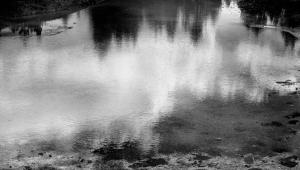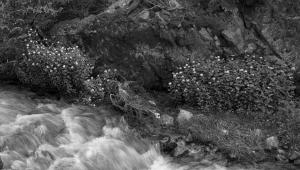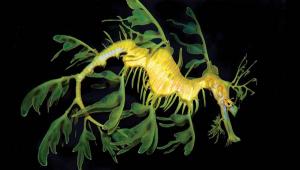The shots are good. I love the quality of the pictures. Good job on this. - Phil Melugin
Epson Stylus Pro 3800
| Epson 3800 |
Well, it seems Epson heard this, and while the 4800 is still available (list: $1995) the new Epson Stylus Pro 3800 (list: $1295) should appeal to those who might not need the roll paper attachment or greater ink capacity cartridges of the 4800. The 3800, it strikes me, is intended for those who want 17" wide printer that is more tabletop friendly both in terms of the space it takes up and its considerably lighter weight. It handles all manner of cut sheet paper, however, in both a high-capacity feeder and, for thicker stock, in pass-through, single cut-sheet fashion. And while not lightweight, this 17" unit comes in at about 43 lbs, considerably better than the 83+ lbs of the 4800.
 |
|
|
The nine inks come in 80 ml carts (the 4800 featured 110 ml carts) with the colors being cyan, light cyan, magenta and light magenta, yellow, light black, light-light black plus photo black and matte black. It being swappable in terms of the photo and matte black, the unit uses 8 inks at a time. This saves on ink during the swap, although some is expended during the process, depending on which way you travel. According to Epson, you lose 4.5 ml during the matte to photo black swap and a mere 1.5 ml when you go from photo to matte black. The best way to avoid this type of ink loss is to simply set up your printer for matte or glossy print runs and not jump back and forth between the two. That's how I worked with the 4800 as well, which ate up a bit more ink on the swaps. The changeover is now a simple menu item on the LED, and not a pull cart in and out dance as it is on the 4800.
 |
|
|
The Pro 3800 can handle prints as small as 4x6", though that size seems
dwarfed by the printer and somewhat odd to run on this machine. It can also
handle up to 1.5mm thick media. There is no bulk feed tray or roll paper accessory
on this unit, or available. You feed through one of three portals--a top
loader that Epson says can hold up to 20 sheets of standard photo media (more
if you want to use it for text printing on bond paper, but why would you do
that?), another single sheet top loader for what they deem "thick"
fine art paper and a front load for poster board type media up to 1.5mm thick.
This printer might just open up printing on supports that you had not previously
considered, which might make it interesting for all the art school multi-media
types out there. It should be noted that when using the front manual feeder
for thick media, size is limited to 16x20".
The UltraChrome K3 inks allow you to print with a good deal of confidence that
whatever you print today will be viable quite far into the future. For the up-to-date
ratings check out www.wilhelm-research.com. Predicted lifespan of inkjet prints
is of course dependent on many factors aside from the media and ink itself and
it's almost bizarre in how it can vary depending on the paper you use.
For example, according to Epson, printing with color on their Enhanced Matte
yields a predicted span of 110 years, yet in black and white on their UltraSmooth
Fine Art you get over 300 years(!)
 |
|
|
Setting up the printer is an easy task. After loading the driver, etc. into
my Mac Book Pro and adding the printer in usual fashion I loaded the ink carts
into the front of the printer, shake and slide in fashion. The printer took
a bit of time to get itself primed, but then gave me the all systems go green
light. The first mode to show up was Photo Black but I wanted to work with Epson's
Velvet Fine Art paper, so using the menu LED I selected Maintenance and then
swapped out to the matte black. It took a few seconds and I was in business.
This being our b&w issue, and b&w being one of my main interests in
inkjet printing, I opened a few images in Adobe Photoshop and chose Epson's
Advanced Black and White mode for my printer settings. I tried some in "neutral"
and then warm and cool settings. The printer hummed along quietly for a surprisingly
short period of time in the 1440 dpi setting and out popped some of the best
looking b&w prints of these shots I've ever printed. A Super A3 (13
x 19") print in warm black and white mode took about 3 minutes from when
the paper first was grabbed by the printer. Connection was via USB 2, which
makes for a fast data exchange.
 |
|
|
There are a couple of matters to look out for, mainly operational things that
once overcome are not a problem. When making the setup page be sure to pick
both the type of paper you are using and the place from which you are feeding
the printer. If you fail to do that you may not get the paper settings right
and the printer will tell you that something is wrong and simply not print.
You may at that point have to reload the paper even if you cancel the print
job. A signal that this is happening is that the paper you want to choose is
dulled out in the profile box. In other words, the feed and paper type is an
important part of the Page Setup process.
If you are feeding the paper from the back note that there are two slot feeders,
one for "regular" paper and one for the thicker art papers. Be sure
to pick the right one. There are some warning signs there that make it fairly
clear. In addition, be sure that the front loader slot is shut when you use
the back feeders, as the printer doesn't like two open feeders at once.
It might take you a second to figure out how to do that but all you need do
is put your hand under the front cover and move the front slot up and out of
the way. It moves naturally enough once you find where it is. In addition, there
seems to be some finicky loading of thicker paper that once mastered will not
be a bother in the future. It takes a certain touch that I got after about three
sheets. In all, be sure to load the Help and Epson LFP Remote Panel from the
supplied CD, as they will be an invaluable in getting you through moments when
the printer simply will not make a print. It's usually something procedural
that needs to be followed to get the flow through right. In other words--sorry--read
the Instructions!
 |
|
|
Would I trade in a 4800 for a 3800, or buy the 3800 instead? Having worked with both extensively it's a hard call. On the one hand the 3800 certainly takes up less real estate and does as good as or in some cases a better job at printing in terms of speed and efficiency. On the other hand the 4800 does have the roll paper feed, a print tray for more sheets than the back, vertical feed 3800 and greater ink capacity, which means less changing of carts. However, as mentioned, with the 4800 you do have to swap carts when going from photo to matte black, a decided pain in the neck. But there are workarounds for that, such as batching jobs for one type of black ink or another.
 |
|
|
I'd say that the 4800 is a workhorse for the studio, print shop or photo
group looking for a high capacity, well put together pigment ink printer, while
the 3800 is prime for the fine art or enthusiast printer who wants 17"
capability in a reasonably sized printer that does a great job right out of
the box. Although $1295 isn't inexpensive, it is certainly a very good
price for a 17" pigment printer of this quality. Those who are committed
to making very long-lasting and vibrant prints for themselves, or their clients,
will find it a good investment. Indeed, it is now my black and white printer
of choice.
www.epson.com
- Log in or register to post comments


This is a good,common sense article.Very helpful to one who is just finding the resouces about this part.It will certainly help educate me.Rolex












































